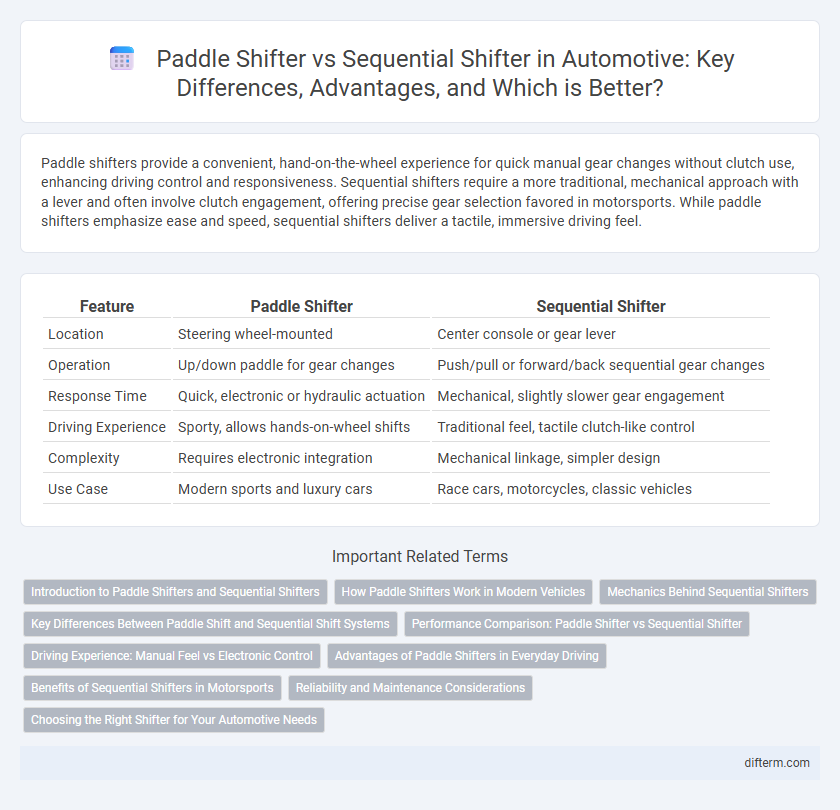Paddle shifters provide a convenient, hand-on-the-wheel experience for quick manual gear changes without clutch use, enhancing driving control and responsiveness. Sequential shifters require a more traditional, mechanical approach with a lever and often involve clutch engagement, offering precise gear selection favored in motorsports. While paddle shifters emphasize ease and speed, sequential shifters deliver a tactile, immersive driving feel.
Table of Comparison
| Feature | Paddle Shifter | Sequential Shifter |
|---|---|---|
| Location | Steering wheel-mounted | Center console or gear lever |
| Operation | Up/down paddle for gear changes | Push/pull or forward/back sequential gear changes |
| Response Time | Quick, electronic or hydraulic actuation | Mechanical, slightly slower gear engagement |
| Driving Experience | Sporty, allows hands-on-wheel shifts | Traditional feel, tactile clutch-like control |
| Complexity | Requires electronic integration | Mechanical linkage, simpler design |
| Use Case | Modern sports and luxury cars | Race cars, motorcycles, classic vehicles |
Introduction to Paddle Shifters and Sequential Shifters
Paddle shifters enable drivers to change gears manually without removing their hands from the steering wheel, offering smooth and immediate gear shifts typically found in modern sports and luxury cars. Sequential shifters require the driver to move the gear lever forward or backward through a linear sequence, mimicking the gear changes of motorcycles and race cars for precise control during aggressive driving. Both systems enhance driving engagement by combining manual gear control with the convenience of automatic-like operation, appealing to enthusiasts seeking performance and responsiveness.
How Paddle Shifters Work in Modern Vehicles
Paddle shifters in modern vehicles operate through electronic or hydraulic systems that allow drivers to manually change gears without a clutch pedal, providing faster and more precise gear shifts. Located behind the steering wheel, these lightweight levers send electronic signals to the transmission control unit, which adjusts gear selection in real-time. Paddle shifters enhance driving dynamics by enabling quicker response times compared to traditional sequential shifters, commonly found in race cars.
Mechanics Behind Sequential Shifters
Sequential shifters operate through a ratchet mechanism that enables gear changes in a fixed order, allowing drivers to shift quickly by pushing or pulling a lever. Unlike paddle shifters that use electronic actuators and sensors for gear changes, sequential shifters mechanically engage the transmission's dog rings to select the next gear. This direct mechanical link provides a tactile and precise shifting experience favored in motorsports and high-performance vehicles.
Key Differences Between Paddle Shift and Sequential Shift Systems
Paddle shifters allow drivers to change gears via levers located behind the steering wheel, offering quick, on-the-fly control without removing hands. Sequential shifters require manual movement of a lever through a fixed gear pattern, providing tactile feedback and precise gear engagement preferred in motorsports. The main difference lies in user interface and shifting speed--paddle shifters enable faster, less intrusive gear changes, while sequential shifters deliver a mechanical, performance-oriented shifting experience.
Performance Comparison: Paddle Shifter vs Sequential Shifter
Paddle shifters offer rapid, seamless gear changes without removing hands from the steering wheel, enhancing control during high-performance driving and reducing shift times. Sequential shifters provide direct, mechanical feedback enabling precise, aggressive gear changes favored in motorsport environments where tactile response and shift accuracy are paramount. Performance-wise, paddle shifters excel in convenience and speed for road and track use, while sequential shifters deliver superior engagement and control for experienced drivers in competitive racing scenarios.
Driving Experience: Manual Feel vs Electronic Control
Paddle shifters offer an electronic control system enabling swift gear changes without clutch engagement, enhancing driving convenience and maintaining focus on the road. Sequential shifters provide a more tactile manual feel, requiring physical gear lever movement that appeals to enthusiasts seeking direct mechanical feedback. The choice between the two influences the driving experience by balancing electronic precision with authentic manual engagement.
Advantages of Paddle Shifters in Everyday Driving
Paddle shifters provide quicker, more precise gear changes without requiring drivers to remove their hands from the steering wheel, enhancing safety and control in everyday driving. Their ergonomic placement allows for seamless shifts during traffic or spirited drives, reducing driver fatigue compared to traditional sequential shifters. Many modern vehicles integrate paddle shifters with automatic transmissions, combining convenience with manual control for improved driving dynamics.
Benefits of Sequential Shifters in Motorsports
Sequential shifters offer rapid and precise gear changes essential for competitive motorsports, minimizing shift times and enhancing overall lap performance. Their design reduces driver error by providing a straightforward push-forward or pull-back mechanism, allowing racers to maintain focus and control at high speeds. Improved durability and reliability under extreme conditions make sequential shifters the preferred choice in professional racing environments.
Reliability and Maintenance Considerations
Paddle shifters generally offer higher reliability due to their electronic design with fewer mechanical components prone to wear, reducing the frequency of maintenance compared to sequential shifters, which rely on robust mechanical linkages that require regular inspection and adjustment. Sequential shifters, while durable in racing applications, can experience increased wear on ratchets and pawls, necessitating periodic lubrication and potential part replacements to maintain optimal performance. Electronic paddle shifters also benefit from software updates and fewer moving parts, minimizing downtime and maintenance costs over the vehicle's lifespan.
Choosing the Right Shifter for Your Automotive Needs
Choosing the right shifter for your automotive needs depends on driving style and vehicle type, with paddle shifters offering quick, ergonomic gear changes ideal for performance and daily driving. Sequential shifters provide precise, mechanical feedback and are favored in racing or off-road scenarios where rapid, accurate shifts are crucial. Evaluating factors like shift speed, control preference, and transmission compatibility ensures optimal performance and driving experience tailored to individual requirements.
paddle shifter vs sequential shifter Infographic

 difterm.com
difterm.com